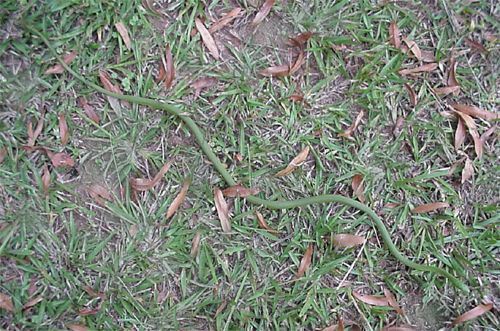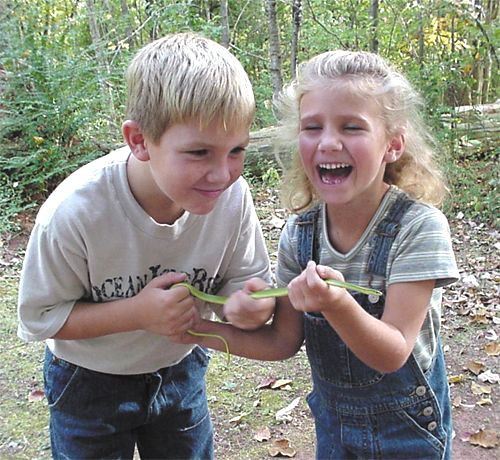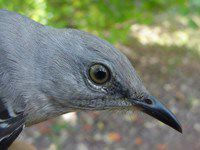 HOME: www.hiltonpond.org |
|
||
| CONTENTS | |||
| RESEARCH | |||
| EDUCATION | |||
| PUBLICATIONS | |||
| MISCELLANY | |||
 |
HILTON POND 15-21 October 2001 |
 HOME: www.hiltonpond.org |
|
||
| CONTENTS | |||
| RESEARCH | |||
| EDUCATION | |||
| PUBLICATIONS | |||
| MISCELLANY | |||
 |
HILTON POND 15-21 October 2001 |
Now You See It, Now You Don't One of the neatest things about nature is that no matter how many times you go to the woods, you can never predict exactly what you may see. That was the case this week at Hilton Pond Center when a visiting group expecting to band birds was confronted instead with an example of nearly perfect natural camouflage.  All photos & text © Hilton Pond Center As the group traversed trails to check mist nets for captured birds, we glanced down and quickly grabbed at something that seemed almost not to be there. The Rough Green Snake, Opheodrys aestivus, is so-called because scales on its back are "keeled"; i.e., each has a central ridge that makes it resemble the underside of a tiny boat (right). The species is widely distributed across the Central, Middle Atlantic, and Southern states, but in the Great Lakes region and New England is replaced with almost no overlap by the Smooth Green Snake, O. vernalis, which--you guessed it--has unkeeled scales. Both species are diurnal and have particularly good vision, allowing them to perceive and capture quick-moving insects that are often just as green as the snakes themselves.
Even though Rough Green Snakes are quite common in the Carolina Piedmont, their camouflage makes them hard to detect. That we were able to see one this week was exciting, but it was even more fulfilling because other folks got to share the experience. Taylor and Rachel (below) were on hand with father Phil Jurney and other representatives of The Impact Fund in Charlotte, and the photo leaves no question about whether these youngsters enjoyed handling a slithery Rough Green Snake at Hilton Pond Center.  If you enjoy "This Week at Hilton Pond," please help Support Hilton Pond Center for Piedmont Natural History. It's painless, and YOU can make a difference! You may wish to consult our Index of all nature topics covered since February 2000. |
 Although the head is nondescript, its "butterbutt" is diagnostic in winter SPECIES BANDED THIS WEEK Ruby-crowned Kinglet--2 NOTABLE RECAPTURES (with original banding dates) American Goldfinch (1) 07/28/99 Downy Woodpecker (1) 05/17/00 Carolina Wren (1) 09/06/00 White-throated Sparrow (1) 12/19/00 Red-bellied Woodpecker (1) 07/04/00 |
WEEKLY BANDING TOTAL YEARLY BANDING TOTAL (2001) 73 species 1,210 individuals BANDING GRAND TOTAL (since 28 June 1982) 122 species 39,493 individuals  The muddy eye of the juvenile becomes clear yellow in adults |
|
Up to Top of Page Current Weather Conditions at Hilton Pond Center |
If you enjoy "This Week at Hilton Pond," please help support Hilton Pond Center for Piedmont Natural History. It's painless, and YOU can make a difference! (Just CLICK on a logo below or send a check if you like; see Support for address.) |
|
Make credit card donations on-line via Network for Good: |
|
Use your PayPal account to make direct donations: |
|
If you like shopping on-line please become a member of iGive, through which 1,800+ on-line stores from Amazon to Lands' End and even iTunes donate a percentage of your purchase price to support Hilton Pond Center.  Every new member who registers with iGive and makes a purchase through them earns an ADDITIONAL $5 for the Center. You can even do Web searches through iGive and earn a penny per search--sometimes TWO--for the cause! Please enroll by going to the iGive Web site. It's a painless, important way for YOU to support our on-going work in conservation, education, and research. Add the iGive Toolbar to your browser and register Operation RubyThroat as your preferred charity to make it even easier to help Hilton Pond Center when you shop. Every new member who registers with iGive and makes a purchase through them earns an ADDITIONAL $5 for the Center. You can even do Web searches through iGive and earn a penny per search--sometimes TWO--for the cause! Please enroll by going to the iGive Web site. It's a painless, important way for YOU to support our on-going work in conservation, education, and research. Add the iGive Toolbar to your browser and register Operation RubyThroat as your preferred charity to make it even easier to help Hilton Pond Center when you shop. |
|
 "HUMMINGBIRD MORNINGS" "HUMMINGBIRD MORNINGS"In 2001, informative and entertaining hummingbird banding presentations were held at four Carolinas locations for more than 500 participants. For more info, and especially if your group would like to host "Hummingbird Mornings" in 2002, click on the hummingbird drawing at left. |
 post questions for The Piedmont Naturalist |
 Nature Study Network |
Hilton Pond Center |
|
|